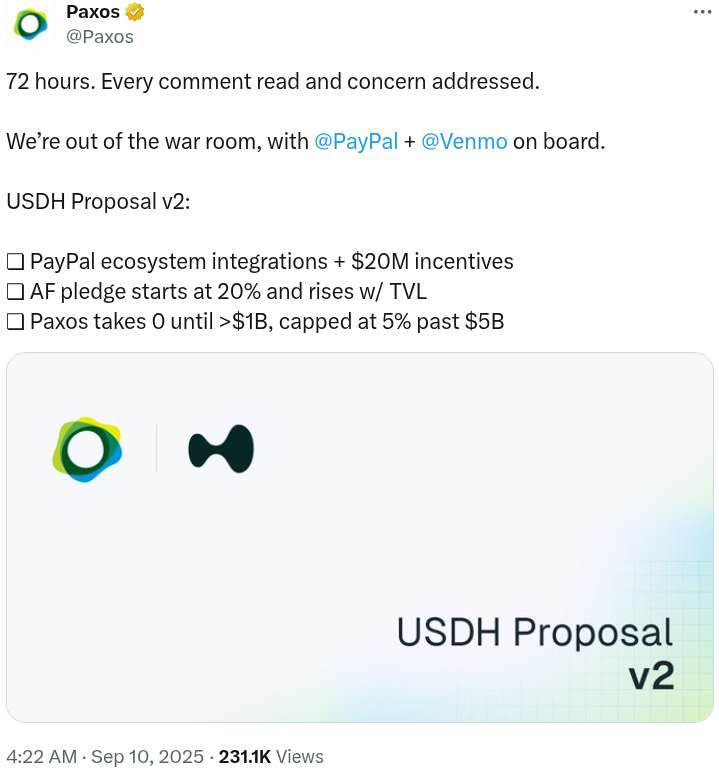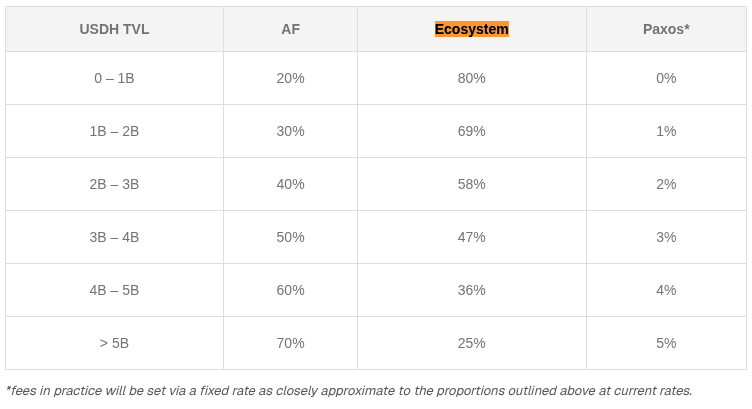The Paxos USDH proposal updates a plan to issue the USDH stablecoin for Hyperliquid, adding PayPal and Venmo integration, $20M in incentives, and a fee model that ties Paxos’ revenue to Hyperliquid’s TVL growth to align issuer incentives with the ecosystem.
-
Paxos USDH proposal adds PayPal and Venmo support for USDH and HYPE checkout.
-
Paxos will earn scaled fees only after Hyperliquid reaches $1B TVL and caps at 5% after $5B TVL.
-
Paxos commits $20M in on‑platform incentives and routes a large share of early fees to ecosystem development and the Assistance Fund.
Paxos USDH proposal: PayPal-backed USDH stablecoin support and aligned fee model for Hyperliquid — read the update and next steps.
What is the Paxos USDH proposal?
The Paxos USDH proposal is an updated plan for Paxos to issue USDH, the native stablecoin for DEX Hyperliquid. The update adds PayPal and Venmo support, $20 million in ecosystem incentives, on/off‑ramps for users, and a revenue model that activates only as Hyperliquid’s TVL grows.
How does the Paxos fee structure align with Hyperliquid’s growth?
Paxos ties its fees to Hyperliquid’s success. Paxos begins earning revenue after Hyperliquid reaches $1 billion in total value locked (TVL), starting at 1% of fees and scaling up to a 5% cap once TVL exceeds $5 billion. Early revenue allocation prioritizes ecosystem development and an Assistance Fund for buybacks and insurance.

Source: Paxos
Paxos updated its bid to issue Hyperliquid’s USDH stablecoin, unveiling a PayPal-backed product with integrated payments and a revenue model linked to DEX growth. The proposal positions Paxos as a stablecoin issuer that only benefits as Hyperliquid scales, with a structured fee distribution aimed at strengthening the HYPE ecosystem.
Why does PayPal support matter for USDH?
PayPal’s commitment to list the HYPE token and support USDH and HYPE for PayPal checkout materially increases on‑ and off‑ramp accessibility. Paxos says PayPal will integrate USDH into Venmo and Xoom, and provide $20 million in incentives to accelerate adoption within the Hyperliquid ecosystem.
What is the Assistance Fund and how will it be used?
The Assistance Fund is Hyperliquid’s protocol-owned treasury that receives platform revenues and fees. It functions as a buyback and insurance mechanism, using revenue to market-buy HYPE tokens and support liquidity and price stability. Over time, the share directed to ecosystem development decreases as TVL grows and more funds route to the Assistance Fund.

Paxos’ fee distribution table. Source: Paxos
When did competing bids emerge for USDH?
Multiple bidders have submitted proposals for USDH issuance. A coalition including MoonPay, Agora and Rain filed a joint proposal, while Ethena Labs and an entity tied to Stripe also submitted competing plans. Agora CEO Nick Van Eck publicly raised concerns about vertical integration and potential conflicts in a Stripe‑linked proposal.
Frequently Asked Questions
How will PayPal integration affect USDH adoption?
PayPal and Venmo integration significantly lowers friction for retail and merchant adoption by adding native checkout support and direct on/off‑ramps, which can accelerate USDH usage across existing payment rails.
What safeguards tie Paxos’ incentives to Hyperliquid?
Paxos commits to earning fees only after reaching TVL milestones and to holding fees in HYPE tokens, aligning its commercial upside with Hyperliquid’s ecosystem health and growth.
Key Takeaways
- Aligned incentives: Paxos only earns revenue after $1B TVL, capped at 5% after $5B TVL.
- PayPal support: Integration across PayPal, Venmo and Xoom plus $20M in incentives improves on/off‑ramp utility.
- Assistance Fund: Protocol revenues will help buy back HYPE and provide insurance for the ecosystem.
Conclusion
The Paxos USDH proposal reframes stablecoin issuance as a partnership model that links issuer revenue to Hyperliquid’s performance. With PayPal and Venmo integration, $20M in incentives, and a TVL‑tied fee schedule, the update strengthens on‑ramp availability while directing early revenue to ecosystem stability. Market participants should watch competing bids and regulatory developments as the USDH issuer decision progresses.
Publication date: 2025-09-10. Updated: 2025-09-10.
